Suzuki Super Carry Mini Trucks
The name ‘Super Carry’ might catch attention with its bold tone, but this Suzuki model stands out for its practical design and thoughtful engineering. It’s clear that Suzuki aimed to compete directly with models like the Daihatsu Jumbo, offering a similarly capable and versatile off-road mini truck.
Jump To Section
Introduction
First of all—’Super Carry’? It’s an eye-catching name that might sound more like a superhero than a Japanese mini truck. But perhaps the best way to understand it is to imagine Suzuki’s designers taking a close look at the Daihatsu Jumbo and deciding to push the concept of an extended cab even further. The Super Carry takes the idea to its logical extreme, delivering a cab that’s as practical as it is spacious.
History
Every great product has a backstory, and the Super Carry is no exception. For 39 years, Suzuki’s Carry was the undisputed king of the Japanese mini truck market. That was until a pivotal moment in 2009, when Daihatsu’s Hijet finally took the lead, becoming the #1 best-selling mini truck.
This wasn’t just a temporary setback. The Hijet has held the top spot every year since, cementing its position as the new leader. For Suzuki, a brand with such a long legacy of success, that loss had to sting. It’s hard to stay on top for decades without feeling the impact when a competitor not only overtakes you but continues to do so year after year.
What could Suzuki do to turn the tide? Looking at Daihatsu’s success, one thing stood out: the breadth of their lineup. Alongside the regular cab Hijet, they offered a variety of options, including dump trucks, the Cargo, the Deckvan, and the Jumbo—a standout model in the Hijet range. In contrast, Suzuki’s lineup lacked direct competitors to the Deckvan and Jumbo, leaving a noticeable gap in their offerings. The solution seemed clear: create an extended cab model to rival the Hijet Jumbo and reclaim a share of that market.
But breaking into an established market is no small task. The kei truck category comes with its own set of restrictions, and simply mimicking the Hijet Jumbo wouldn’t guarantee success. Suzuki needed something to set their model apart. Their answer? Don’t just extend the cab—super-size it. That’s exactly what they did.
The result was the Suzuki Super Carry, a bold and ambitious addition to their lineup. But the key question remains: Did Suzuki do enough to create a model that could stand out from its arch-rival, the Hijet Jumbo? Let’s compare these two off-road Japanese mini trucks side by side and let you decide for yourself.

Interior
As you might expect, the extended cab on the Super Carry adds a significant amount of space. An extra 1 1/2 feet extends out the back, while an additional 4 1/2 inches of headroom makes the cab noticeably more spacious. In the world of Japanese mini trucks, those numbers represent a meaningful upgrade. Of course, seeing is believing, so let’s take a closer look. First, here’s the standard Suzuki Carry regular cab model as a reference—showcasing the classic cab design without the extended features.
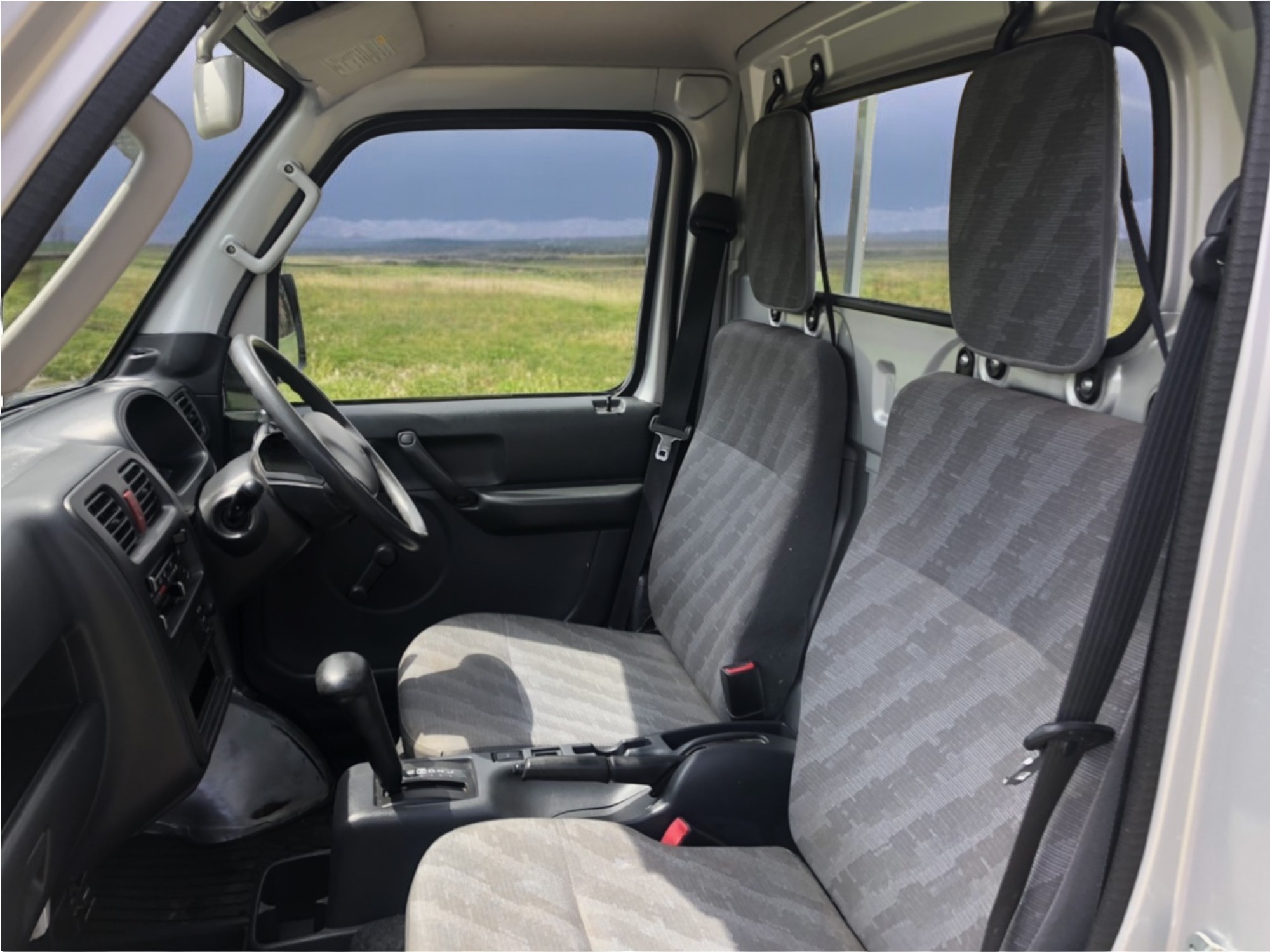
Now, let’s take a look inside the Suzuki Super Carry cab. The extended cab truly provides a noticeably larger space, and as you can see, the area behind the seats offers a practical and spacious shelf—perfect for storing toolboxes or other items you’d rather keep protected from the elements.
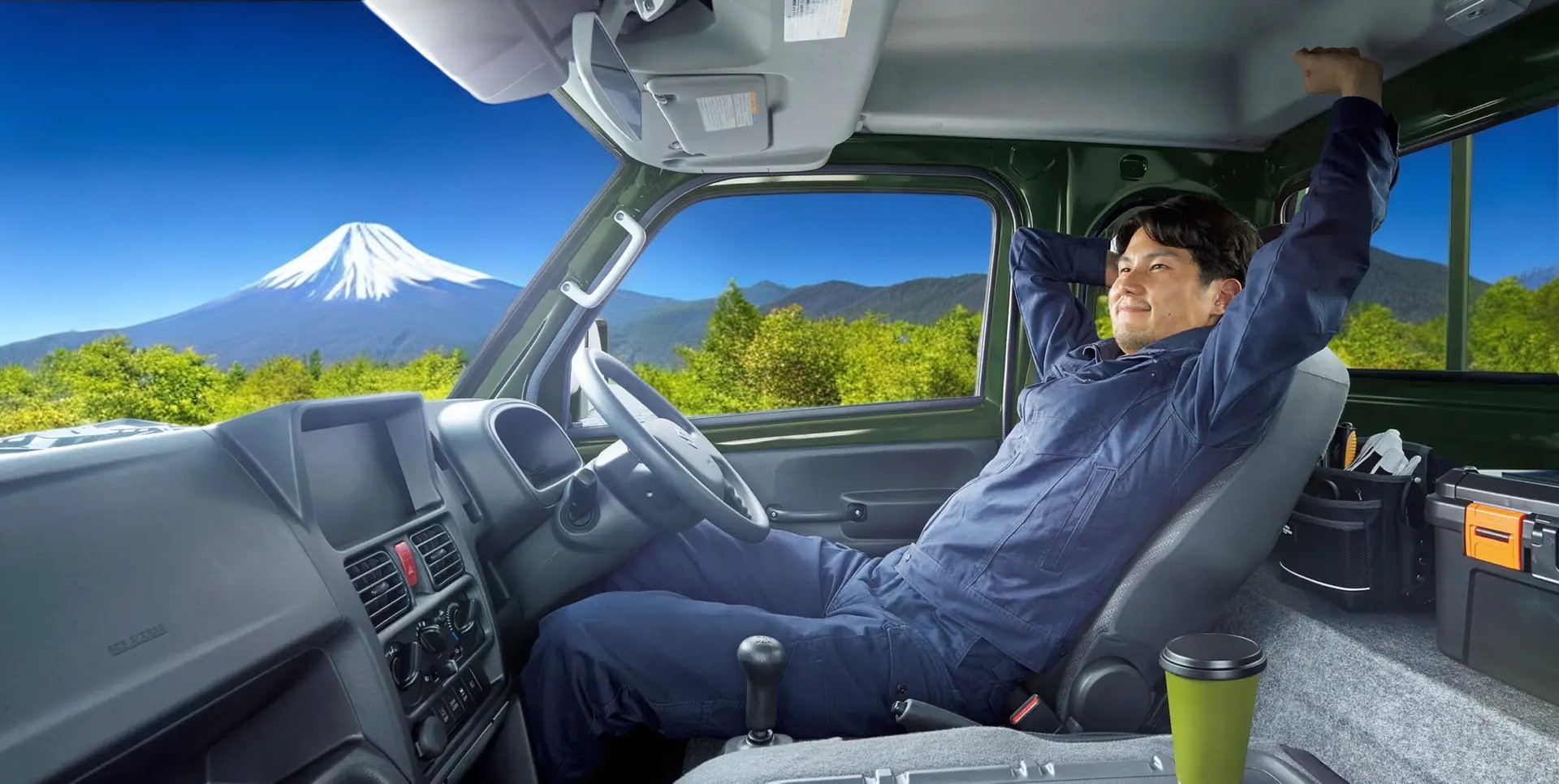
If you’re the size of our reference model, you’ll find plenty of room to stretch out. But even for taller Americans, the cab provides ample space to get comfortable. It’s not just about the overall size, though. As we’ve already seen, the shelf behind the seats offers a practical spot for toolboxes and other gear you’d rather keep protected from the elements, as demonstrated here. But there are more thoughtful touches to notice in this photo if you take a closer look…
- Check out the ceiling area at the front of the cab. See the section with the sun visors? It looks distinct from the rest of the roof—and that’s because it is. It’s an overhead shelf, providing extra storage space up high. While you’ll want to avoid storing anything heavy or unsecured that could fall during off-road driving, this shelf is perfect for keeping smaller items within easy reach but out of sight.
- And speaking of clever design, take a look at the seats. Notice the driver’s seat—our model is seated there. But what about the passenger seat? That’s right—it’s folded down flat, doubling as a table with a durable plastic tray back. You can see his coffee resting on it, though of course, this only works when you’re parked up. But if it’s just you in the cab, this fold-flat seat offers some additional utility for keeping items secure and organized.
A roomier cab isn’t just about storage or extra features, though. More space means greater seat adjustability, giving you more ways to find the perfect position and stay comfortable.
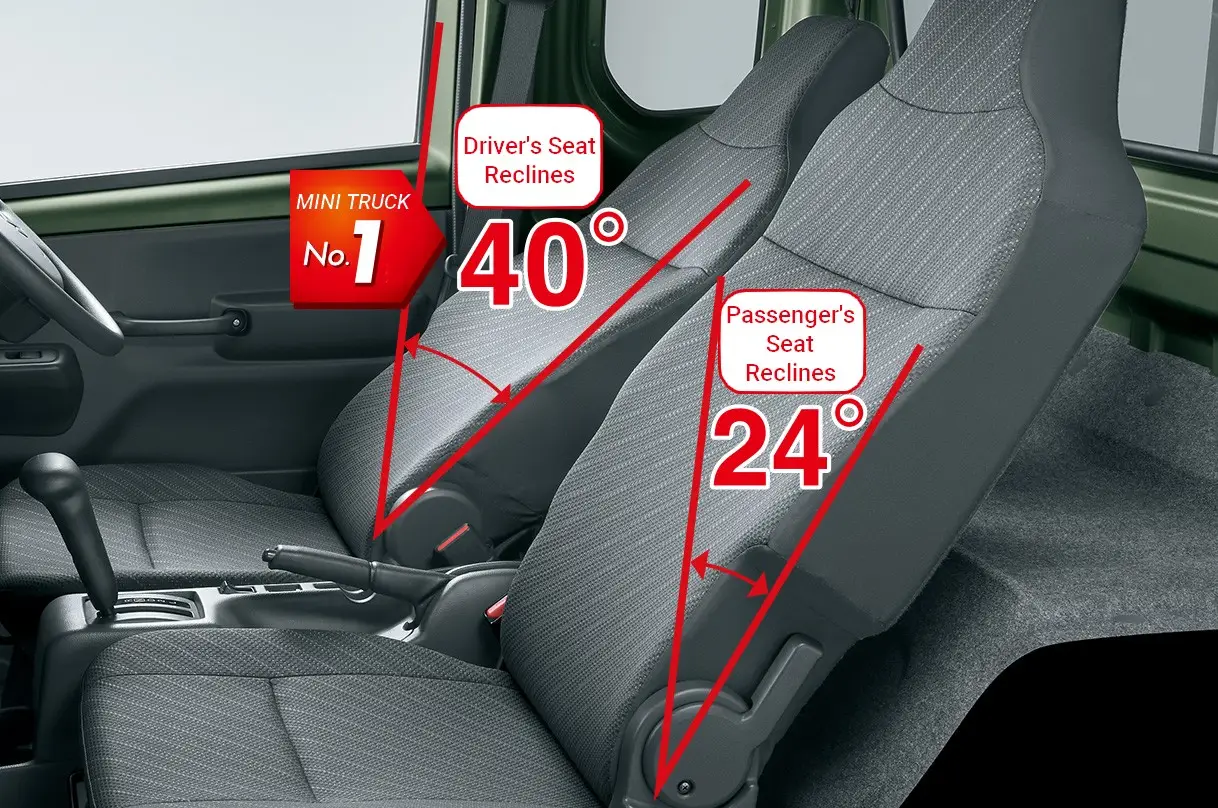
In case you’re wondering, here are a few features that make the Suzuki Super Carry a significant upgrade from a typical UTV:
- UV-cut window glass all around for added comfort and skin protection.
- Adjustable air conditioning and heating to keep the cabin comfortable in any weather.
- Power windows on some models, while others feature durable manual wind-up windows.
- Plenty of storage options throughout the cabin—not just the glove compartment and overhead shelf. Need a spot for your phone? Sorted. Want to keep your keys secure and easy to find? Done.
- And if you’re bringing along a water bottle or coffee mug, there’s a convenient cup holder for that, too.
Exterior Colors
The cab of the Super Carry is a comfortable place to spend your time, with plenty of thoughtful storage options that make it highly practical. On the outside, though, the story is a little different. The extended cab, while adding valuable space, gives the truck proportions that aren’t exactly the most elegant. It’s fair to say the Super Carry’s exterior design leans more toward functionality than aesthetics. However, it doesn’t have to be a tough truck to look at. Suzuki offers a range of surprisingly subtle and stylish color options that can elevate the appearance of your extended cab model, giving it a more refined and classy look.
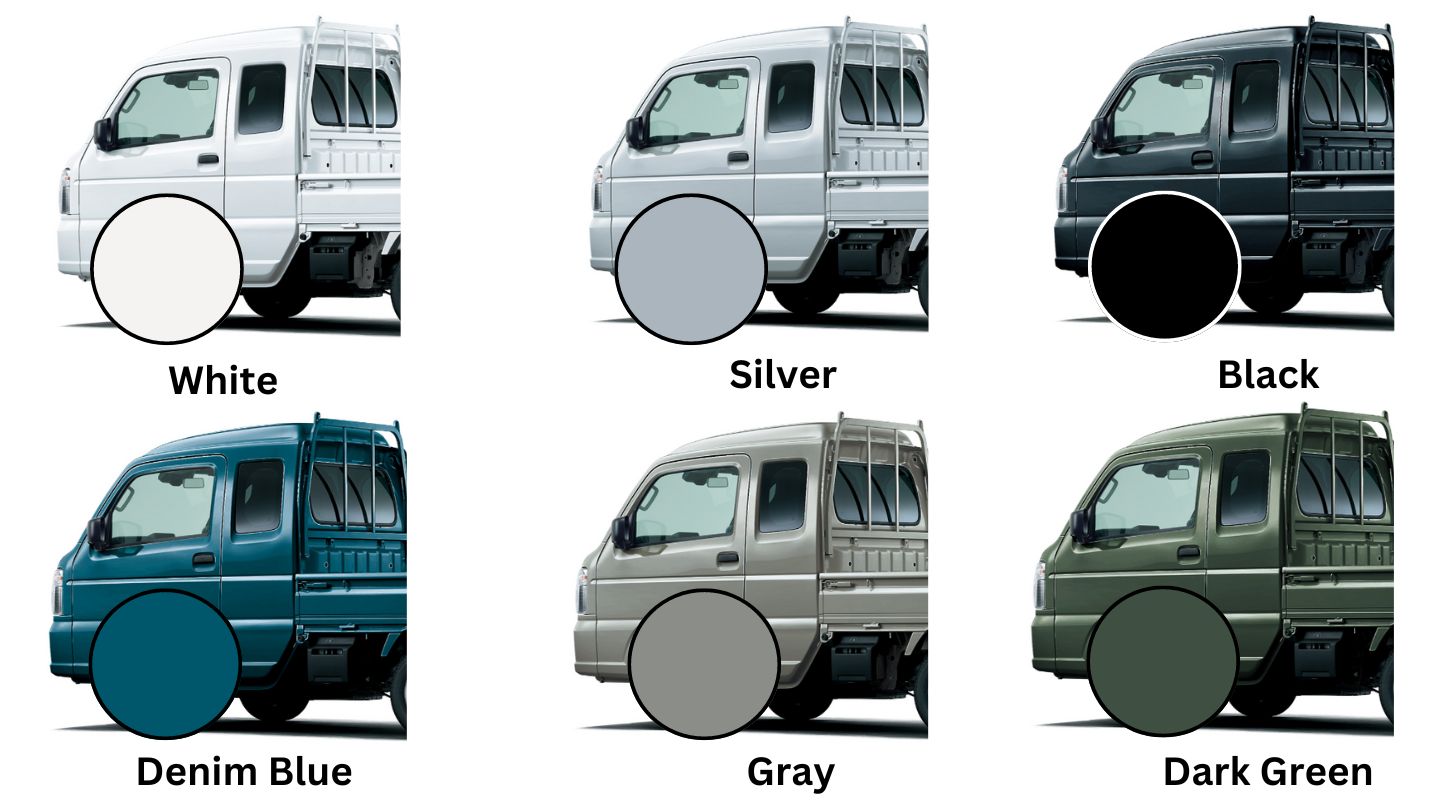
Engine & Transmission
You’ve got a spacious and practical cab to serve as your ‘office’ while navigating off-road terrain around your farm. But, of course, how you get around is just as important. That comes down to the engine and transmission in your Suzuki Super Carry mini truck. Like the Daihatsu Hijet, the Super Carry operates within the same strict rules that apply to all kei mini trucks. With that said, let’s dive into the details, starting with the engine.
Engine
The engine in the Super Carry is the same unit found in the regular Carry models. It’s Suzuki’s R06A-type 3-cylinder, water-cooled engine with electronic fuel injection and variable valve timing. This engine delivers maximum power at 5,700 rpm, while peak torque comes in lower, at 3,500 rpm. Both the R06A in the Carry and the KF engine in the Daihatsu Hijet hit their power peaks at the same 5,700 rpm, but the Suzuki engine reaches maximum torque 500 rpm earlier than the Daihatsu KF engine. This earlier torque delivery gives the Suzuki a slight advantage in pulling power over difficult terrain, although both engines are highly capable in this regard.
The R06A engine represents a significant improvement over its predecessor, the K6A. It has 10% less internal friction and was the first kei mini truck engine to feature variable valve timing (VVT). At the time of its launch, it was also the lightest engine in its class. However, with the DA16T now nearing a decade in production, the R06A has been overtaken by the latest Daihatsu Hijet engine, which incorporates start-stop technology for better fuel efficiency. How Suzuki will respond to this advancement remains to be seen, but an update to the DA16T is likely in the near future.
These engines are built to NVH (Noise, Vibration, Harshness) standards that exceed what you’d expect from a UTV like this. While quiet running might not seem like a big deal, it makes a noticeable difference during long workdays. Having an engine that runs smoothly without grating on your nerves adds to the overall comfort when working on your ranch or farm all day.
When it comes to maintenance, the R06A engine is straightforward and practical. It runs on regular gasoline, and replacement parts like air and oil filters are easy to source and install. If you experience cold winters, using antifreeze is essential, just as with any other UTV. Routine maintenance is simple, and most tasks can easily be handled without specialized tools.
As for its placement, the engine is mounted under the cab, positioned low beneath the seats. This design contributes to the Super Carry’s excellent low center of gravity, ideal for off-road performance. The seats are easy to remove, giving you convenient access to the engine for tasks like oil changes or minor repairs.
For a better look at the engine, here it is in its compact form—an example of engineering precision. In many ways, the craftsmanship here is as impressive as the workings of a Swiss watch.
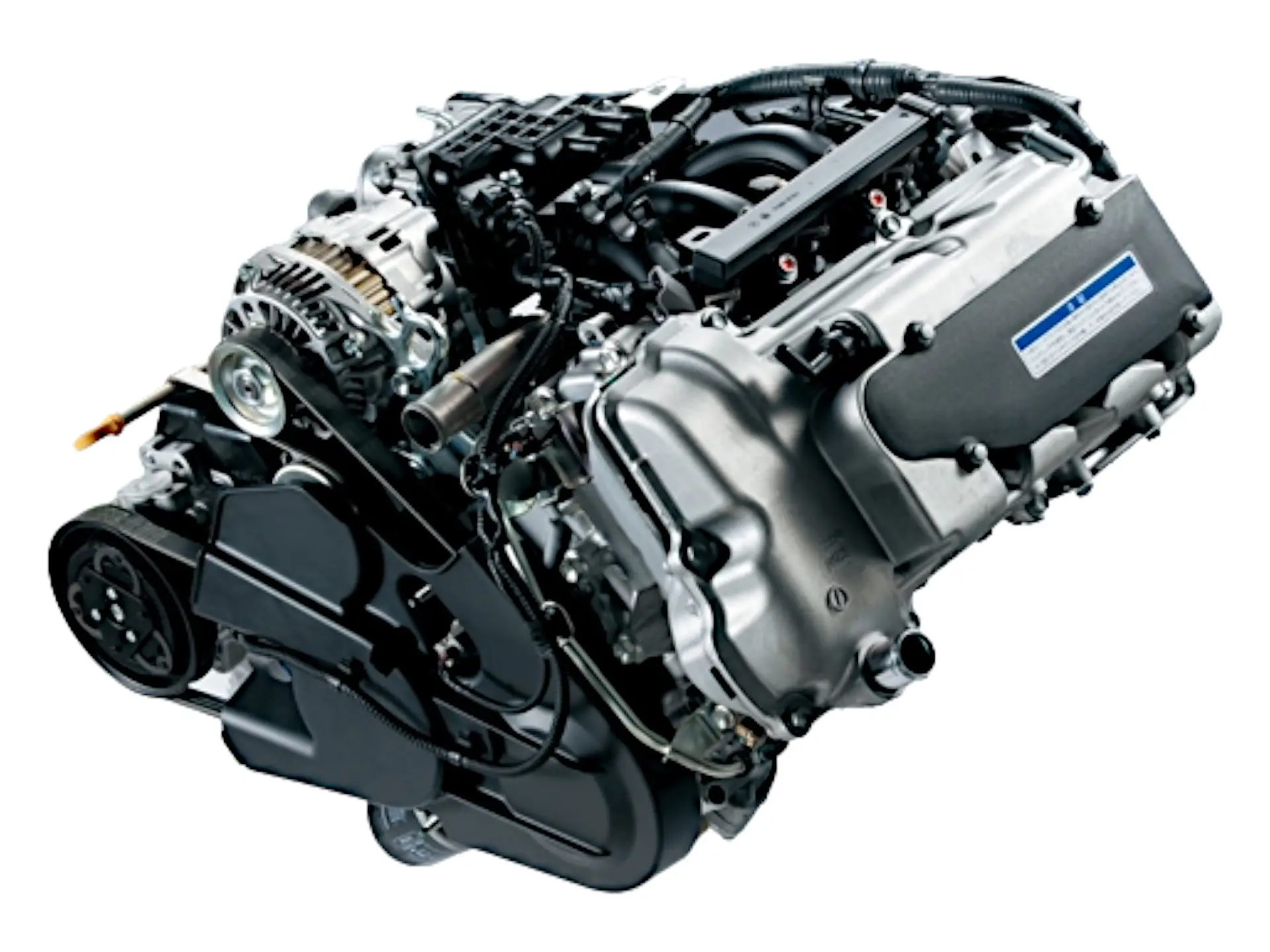
Transmission
While Daihatsu offers two transmission options—automatic or manual—Suzuki provides three: automatic, manual, and an unusual hybrid of the two called ‘5AGS’ (more on that later). Let’s start by looking at the manual transmission.
Manual Transmission
The Carry mini trucks—both the regular and ‘Super Carry’ models featured on this page—come with a 5-speed manual transmission. Some of these models also include a hi-lo switchable range, often referred to as the ‘Farming Package.’ However, there’s a noticeable difference between the hi-lo range lever in the Super Carry and the simpler version found in the Daihatsu Hijet Jumbo. Can you spot the difference?
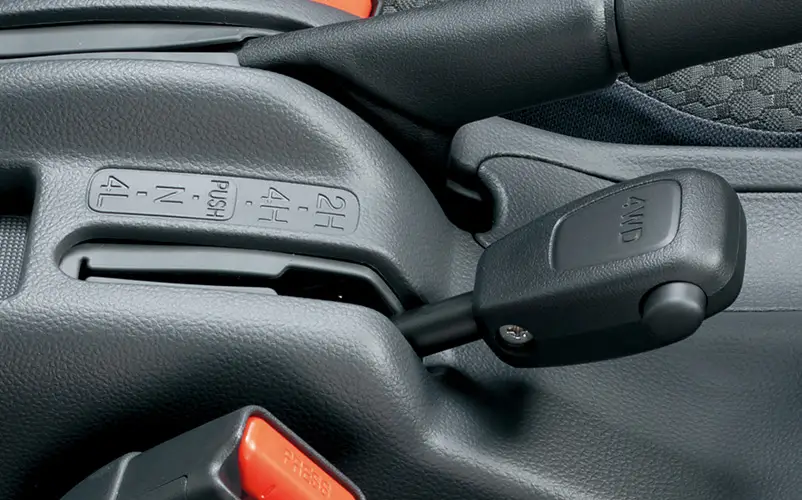
That’s right—you’ve got these additional settings labeled ‘4L,’ ‘4H,’ and ‘2H.’ But what do they mean? Essentially, they provide extra flexibility to adapt your mini truck to different driving conditions:
- 4L: The Super Carry is in 4WD mode with ‘Low’ range—ideal for tasks like climbing steep slopes where extra torque is needed.
- 4H: The Super Carry is in 4WD mode with ‘High’ range—perfect for driving on a snowy track that isn’t particularly steep or slow-going.
- 2H: The Super Carry is in 2WD mode with ‘High’ range—best for higher grip situations such as when you’re driving on a packed dirt track.
Automatic Transmission
The auto DA16T Super Carry comes equipped with a traditional 3-speed automatic transmission, similar to what older Daihatsu Hijet models used to feature. However, this is an area where Suzuki has fallen behind. Daihatsu has since replaced their traditional automatic with a CVT transmission, which offers significantly better fuel economy compared to the older automatic. It remains to be seen how Suzuki will respond, but it wouldn’t be surprising if they make the same transition in the future.
A new Suzuki Super Carry mini truck is likely on the horizon at some point, as the DA16T is showing its age. When it arrives, it wouldn’t be a surprise to see Suzuki adopt a CVT in place of the traditional automatic, bringing their mini truck in line with more modern offerings.
5AGS automatic transmission
The ‘5AGS’ transmission may seem like just another complicated acronym, but it actually contains some really interesting tech: You see ‘AGS’ stands for ‘Auto Gear Shift,’ while the ‘5’ refers to the number of gears. In essence, it’s a 5-speed manual transmission that can also shift automatically. This design offers improved fuel economy compared to a traditional automatic while maintaining the convenience of automatic shifting. Additionally, it provides the option for manual control when needed.
In practical terms, the 5AGS allows you to choose between fully automatic and manual modes, giving you flexibility based on your off-road driving situation. However, it’s important to note that 5AGS models do not come with a hi-lo range or a locking differential, which are features available on the true manual transmission versions.

4WD System
First, not that all the Japanese mini trucks here at Mini Truck Depot are strictly for off-road use, and as you’d expect, they all come equipped with 4WD.
Just like the older Hijet Jumbos, the DA16T Suzuki Super Carry also includes a button that allows you to switch between 2WD and 4WD. Most of the time, leaving it in 4WD will be the best choice. However, there are times when switching to 2WD makes sense to save fuel, as the extra grip provided by 4WD may not always be needed. For example, when driving on a packed gravel track, powering all four wheels is unnecessary. In these situations, the 4WD button offers the option to make that fuel-saving adjustment.
That said, Suzuki has been outpaced in automating this feature. Daihatsu introduced an upgraded system with its late 2021 11th generation Hijet that automatically switches between 2WD and 4WD. This system uses onboard electronics to monitor conditions and ensure the mini truck is in 4WD only when required, such as on slippery or uneven surfaces. This automated process eliminates the need to press a button manually each time and helps optimize fuel economy.
For now, Suzuki has yet to introduce a similar system in the Super Carry. While it remains to be seen how Suzuki plans to address this, they are currently behind the latest Hijet in terms of technology in this area.
Load Bed
At 6 feet 6 inches in length, the floor of the Suzuki Super Carry’s load bed is still long—only 2 inches shorter than that of the regular cab Carry. However, it’s important to note that you only get the full length when your load slots into the recessed nook right at the base of the cab. Since you can’t change the laws of physics, all the extra space added to the cab has to come from somewhere. As a result, the usable load area measured from the back of the cab above that nook is reduced to 4 feet 10 inches.
It sounds like a drastic reduction but, to put that into perspective, this is still plenty of prime hauling space when compared to most UTVs. It’s only in comparison to other mini trucks that the load bed starts to seem less impressive. Even with the reduced space, the Super Carry can still haul just as much weight as the regular Carry, meaning it doesn’t lose any of its utility. Ultimately, the key question is how much space you need in the load bed versus how much you want in the cab for yourself and your passenger.
That’s the equation to consider when deciding whether the Suzuki Super Carry with its spacious cab, the Daihatsu Hijet Jumbo with its slightly smaller cab, or a regular cab model like the Carry or standard Hijet is the right fit for you. While we can’t give you that answer, understanding these trade-offs should help guide your decision.
Buying A Suzuki Super Carry Mini Truck
Suzuki Super Carrys are super rare, so it’s not often you’ll find them here at Mini Truck Depot. Actually, Daihatsu Jumbos seem to be the preferred extended cab mini truck option in the US, which is why they always outnumber the Super Carrys on our mini trucks for sale page. But if you can’t find one? Contact us and we’ll see if we can find one for you.

